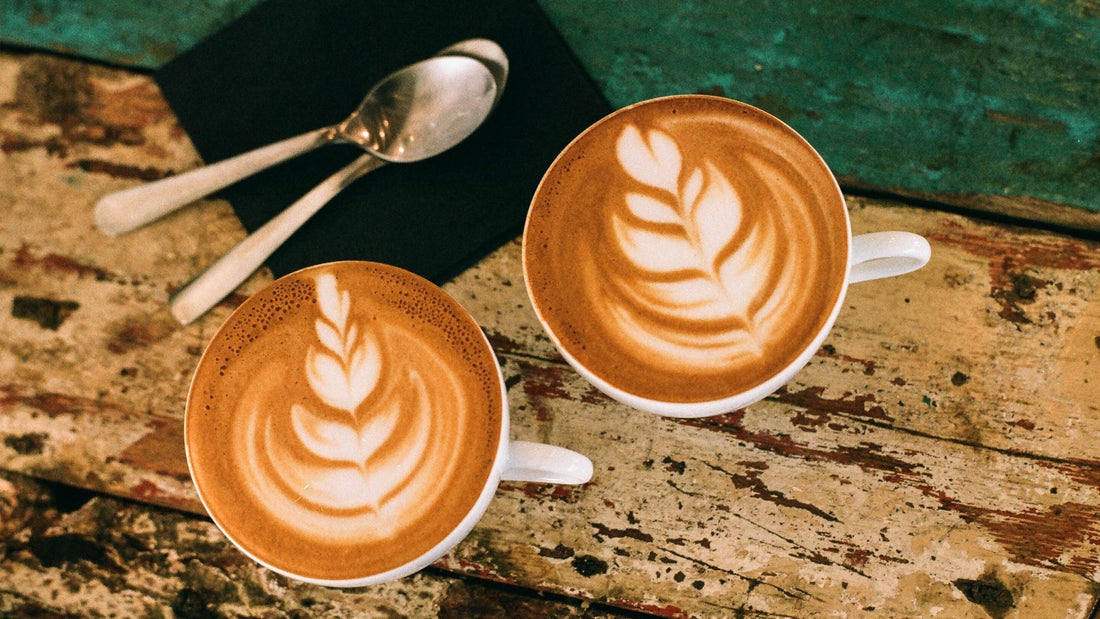It all feels so fancy when a perfectly over filled cup, with swans floating all over them is served hot to you! Yes, lattes are absolute works of art that also taste like liquid slices of heaven. Making them, however, can become a handful. Café Latte, this gorgeous looking drink originates in Italy. It is a form of milk coffee that was found back in the late 19th century. The Italians now, almost always make it at home for breakfasts. Yes, it is that popular over the country and worldwide now. Latte Art is one of the most famous edible art practices in the industry at present. A standard international latte is a sub branch of the Espresso infused coffees and has similarity with cappuccino. Certain ingredients: Steamed milk, Espresso shot, milk foam.
A large cup is first filled by either a single (30ml) or double (60ml) shots of Espresso which is then topped by a thick layer of steamed milk (about 250 to 300 ml) that makes for most part of the drink. This is topped by a thin layer of foam. It comes from the phrase café e latte. The taste is supposed to be distinctly subtle and creamy making it a loved favorite of coffee novices and lovers. As fixed as they are, the ingredients of a good latte can very well be tweaked, introducing the drink to endless possibilities. Believe it or not, a black latte exists too, helps you lose weight!
Creating a smooth and perfect sip of latte is all about the balance of the three layers that form it and the quality of beans used. Amounts of ingredient put play a major role too. Some of the gentle reminders can be like not putting too much coffee to overpower the milk. You can always begin with noting down the difference in taste and texture as you experiment with the amount of milk, coffee and foam you use.
Use the right amount of coffee…
Apart from choosing the finest beans for your café latte, the amount of coffee that goes behind it is going to make the biggest difference in the drink. As cool and edgy guessing with your hand measurements are, we suggest you stick to electronic scales and conventional brewing tools to go ahead, even if you are a home brewer. Also, the golden coffee ratio should be kept in mind… go for the classic 1:17 ratio of coffee and water for the drink to not have an overpowering mouth feel and acidic aftertaste. Consistency with your brewing can also be helped by this method, just take 1 gram of coffee for 16 milliliters of water for that smooth and subtle latte feel. There is no hard and fast rule however, if you like your drink slimmer or thicker, have fun with it!
Also, if you follow an electronic scale with 1 gram increments, you can easily fine tune ratios as you keep increasing or decreasing. This creates a balance in your latte and more than anything regular ratios make you quite the expert at latte making experiments and regulars.
Make sure you use finely ground coffee…
The best bet you can opt for is the consistency of a sand grain or finely grained salt. Every type of drink needs a special bonding strength of the coffee grain particles for the water to pass through them at a certain pressure. Whether you go for an espresso, an Americano or a latte, grain strength is a major influencing factor to ensure you are getting the most out of your beans. From a coarse gravel or stony structure to a grainy or salt like strength, it all actually affects the taste of your latte. The finest taste can be achieved with the finest ground, resembling closeness to a fine powder; it brings that soft subtlety to your latte. So, wherever you are getting the ground from, or if you are a home grounder go for the maximum finesse.
Go for colder milk when you go for your latte…
The milk frothing process is of primal importance in the taste making of a latte… so before you go ahead with it, do what you can to remove whatever condensation is there in the frother’s steam system which keeps excess water off of your milk. And yes its true, using cold milk to froth your latte actually makes it better! How? The colder the milk the higher its possibility of receiving air because warmer temperature liquids cannot grasp as much air as a colder temperature one… And the more air your frothing receives the better the milk frothing will turn out to be!
As a preparatory step, place your milk as well as the frothing pitcher in the refrigerator from beforehand. Cold pitchers are known to be contributing for extending the time so that more air can get inside the milk, bringing that smooth foamy consistency to it.
Positioning of the wand…
The goal is to make a milk whirlpool which will have a load of air bubbles and suck in all the air to make for a smooth and silky drink. The smoother and silkier your milk, the lighter and expanded its quality and texture, the closer you are to a typically perfect latte. Therefore holding the wand of your pitcher at a right angle is of prime importance. The tip of the wand should be just at the center of the pitcher and the pitcher should be leaning a little to make the wand third of the way. Then just witness the pretty whirlpool of milk your cup will create.
Begin with the base and then shift to art…
Latte art is a whole other world of fine artistry. Years of repetitive practice, dedication and a bit of magic is what make swans float on your beautiful drink. The main point to remember while making latte art is contrasting! The base should be of strong brown coffee. Pouring the coffee in this brown base needs certain angles and throwing from a certain height. Start by pouring the milk gently so that it percolates the crema, going under. Consider the brown liquid to be your art canvas. Create two heights, one about 5 cm for the base and the other about 0.5 cm for the art. Start pouring to the middle of the cup and gently pour in circular motions till it is full to about 40 to 70 %. The surface tension of the cup rises the fuller the cup is. Now begin pouring the design on your cup, remembering that the bigger your design the earlier you should start.
For smaller tips, keep the temperature of your milk in check, for the milk to react and maneuver the way you want it to, 70 degrees is the absolute maximum you can allow. Use the finest coffees, lean closer to your cup while pouring, like the swans both you and the cup should be tilted towards each other. Go close and slow and hearts will start popping up, they will! Repeatedly learn other people making lattes, make your own pattern from the best of brewing patterns…

